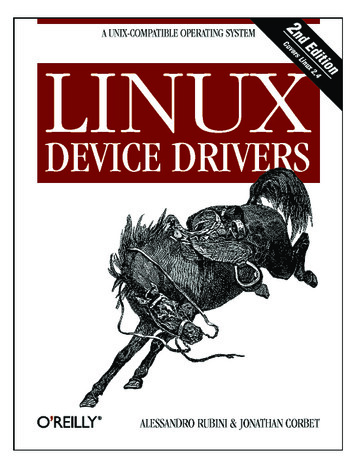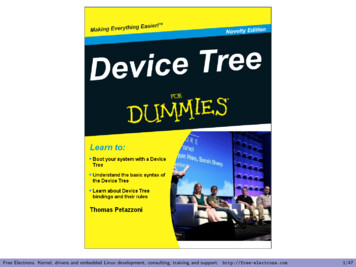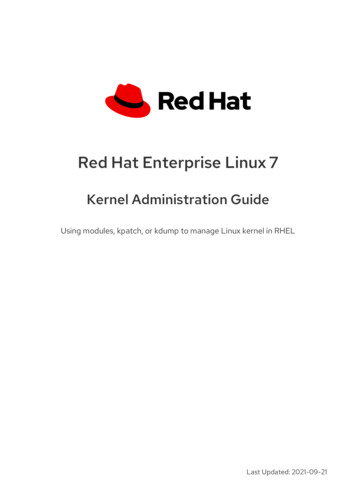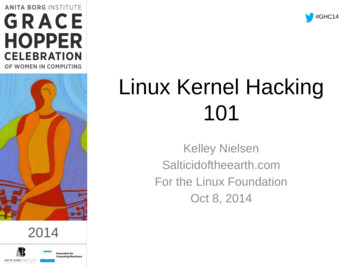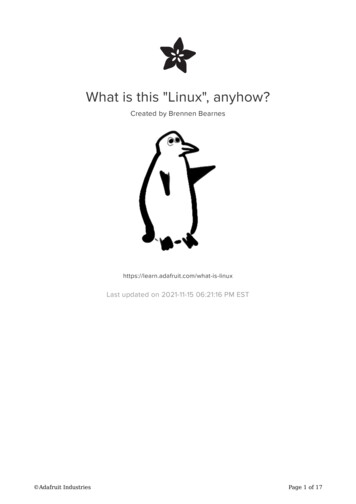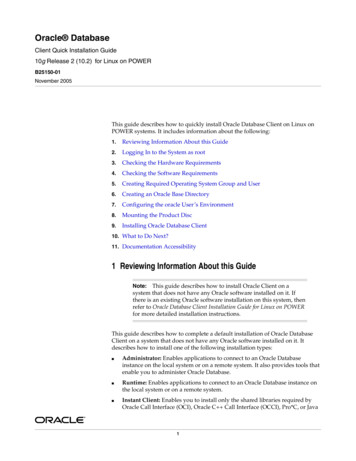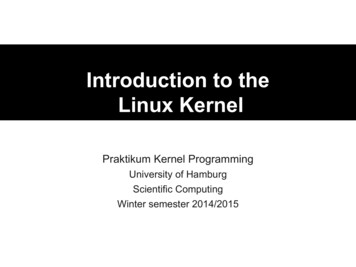
Transcription
Introduction to theLinux KernelPraktikum Kernel ProgrammingUniversity of HamburgScientific ComputingWinter semester 2014/2015
Outline What is an Operating SystemHistory of Operating SystemsTypes of Operating SystemsThe Linux KernelSummary
What is an OS Hard to define Abstracts a set of hardwareresources High level interface instead ofmachine code e.g File storage from blockdevices Resource management Multiplexing (sharing) resources e.g Assign CPU time Hardware
Outline What is an Operating SystemHistory of Operating SystemsTypes of Operating SystemsThe Linux KernelSummary
1st Generation Vacuum Tubes (1945-55) 20.000 vacuum tubes where used Programming was done in absolutemachine code Assembly language was unknown Each program used the machineexclusively Most famous ENIAC Announced in 1946 Solve large class numericalproblems
2nd Generation Transistors and batch systems(1955-65) Designers / Builders / Operators /Programmers / Mainterers Programmers first wrote the programin paper, then punch it on cards Card readers to read the programsource Output stored on tapes and alsoprinted 1st use of Compilers (FORTRAN)
3rd Generation ICs and Multiprogramming (1965-1980) IBM 360 Mainframe Multiprogramming Several programs in memory at onces withseparate memory Overlap I/O with Computation Timesharing Each user has an online terminal CTSS (Compatible Time Sharing System) MULTICS (MULTiplex Information and ComputingSystem) UNIX, a stripped-down version of MULTICS BSC (Berkeley Software Distribution)
4th Generation Personal Computers (1980-today) SYSTEM V, 1st commercial UNIX operating System(1983) LSI (Large Scale Integration) IBM PC (early 1980) Intel 80286 CPU DOS (Disk Operating System) MS-DOS (Microsoft DOS) LISA First Computer with GUI Protected memory, preemptive multitasking,
Modern Operating Systems
Outline What is an Operating SystemHistory of Operating SystemsTypes of Operating SystemsThe Linux KernelSummary
Types of OS’s Multi-user Multiple users access the computer simultaneously Single-tasking Only one running program Multi-tasking Allows more than one program to run parallel Two types: Pre-emptive, the OS slices the CPU time anddedicates one slot to each of the programs Co-operative, each process give time to the others Real-time Aims at executing real-time applications
Types of OS’s Distributed Manages a group of independent computers andmakes them appear to be a single computer Templated A single virtual machine image as a guest operatingsystem, then saving it as a tool for multiple runningvirtual machines Embedded Designed to be used in embedded computersystems
Monolithic kernel Single image that runs in a single addressspace A set of primitives operations are implemented inoperating system level Process management Memory management Device Drivers Trivial (IPC) Inter Process Communication Easy to design Difficult to maintain and extend Examples: MULTICS, SunOS, Linux, BSD
Micro-kernel The minimum amount of software that providethe mechanisms needed to implement an OS Also known as μ-kernel Provides Build in IPC Low level address space management Thread management Easy to extend Performance penalties (requires IPC calls) Examples Symbian, Mac OS, WinNT
Monolithic VS. μ-kernelEverything that runs in kernel mode defines the OSSource: er/File:OS-structure.svg
Outline What is an Operating SystemHistory of Operating SystemsTypes of Operating SystemsThe Linux Kernel Introduction (story, licence, versioning)Main partsLoadable Kernel ModulesSystem CallsSecurity Summary
Introduction Developed by Linus Torvalds (1991) Just for Fun: The Story of an AccidentalRevolutionary by Linus Torvalds Based on Unix 1st version supported Intel 80386 Currently various platforms are supported Implemented in GNU C Several Distributions (distro) RedHat, CentOS, Ubuntu, SUSE, Debian, Arch Different package system, configuration etc. Apply different patches
Introduction (cont.) X-Server is not implemented within the Kernel Everything run in “Kernel mode” Privileged access to hardware Monolithic but boasts modular design Kernel preemption (under certain conditions) The scheduler is permitted to forcibly perform acontext switch Supports kernel threads Dynamic load and unload binaries (kernel modules) Reentrant, several processes can be in kernel modesimultaneously
Introduction (cont.) License Terms is licensed under the Version 2 of the GNU GeneralPublic License (GPL) Allows anybody to redistribute and even sell a productcovered by GPL as long as the recipient has access tothe source and is able to exercise the same rights Any software derived by a product covered by GPLmust be released under the GPL Democratize, everyone can contribute If you want your code to go into the mainline or youhave modified the kernel then you have to use GPLcompatible license
Introduction (cont.) Use of binary Blobs (Modules, firmware) The source is not given May contain part of the driver from another file system If the code has been ported from another operatingsystem is legal If a company wants to keep the source private Using such software is discourage Versioning uname -a3 . 17 . 1major . minor . revision
Linux system overviewHardwareKernelShellΑpplications
Request flowApplicationsPrivileged modeKernelShellHardware
Outline What is an Operating SystemHistory of Operating SystemsTypes of Operating SystemsThe Linux Kernel Introduction (story, licence, versioning)Main partsLoadable Kernel ModulesSystem CallsSecurity Summary
Main partsSystem Call InterfaceProcessManagement (PM)Virtual FileSystem (VFS)MemoryManagement (MM)NetworkStackArchDevice Drivers(DD)
Main parts (cont.) System call interface (SCI) A thin layer that provides a method to interact fromuser space to kernel space Process Management (PM) Create, destroy processes Communication between different processes (kernelthreads) CPU scheduling Memory Management (MM) Physical to virtual memory management Memory allocation Swapping, from memory to hard disk
Main parts -- I/O Path Virtual File System (VFS) Eports the common file interface Abstract file system functionalityfrom implementationVFSext4XFS/proc File Systems Implementation of FS functionality Buffer Cache A set of functions to manipulatemain memory designed for FS Device Driver Physical Device Where data liveBuffer CacheDevice DriversPhysical Devices
Main parts (cont.) Network Stack Implement the network protocols Deliver packets across programs and networkinterfaces Device Drivers (DD) Interact with the hardware Extract an abstraction of the device functionalities Arch Architecture dependent code
Outline What is an Operating SystemHistory of Operating SystemsTypes of Operating SystemsThe Linux Kernel Introduction (story, licence, versioning)Main partsLoadable Kernel ModulesSystem CallsSecurity Summary
LKMs LKMs (Loadable Kernel Modules)Pre-compiled binary piecesEach piece is called “module”Can be loaded at runtimeExtend the functionality of the systemEnforce modularity Easy to develop, debug and maintain No need to rebuild the kernel Can save memory (load only the necessary)
What are LKMs used for Everything that is not required in the core 6 main categories Device drivers File system drivers Implementation of a specific file system System calls Network stack Interprets a network protocol TTY line disciplines Executable interpreters for the supported formats
Character Device Driver Read or Write a byte at a timeAccessed by a stream of bytesUsually permit only sequential accessImplement: open, close, read, writeSimilar to regular filesExamples: /dev/console /dev/ttyS0
Block Device Driver Read or Write block-size multiplesPermit random accessAccessed in the /dev/File systems can be mount on topHandle I/O operationsDiffer with the char module in the way themanage data inside the kernel Different interface to the kernel than charmodules
Network Drivers Handle any network transaction madeTransfer packets of dataIndependent of a specific protocolReception and Transmission instead of Read/WriteUsually the interface is a hardware device but it canalso be software like the loopback loopback is used to communicate with the serversthat run in the same node, debugging etc. They are not mapped to the file system; they areidentified by a name
Outline What is an Operating SystemHistory of Operating SystemsTypes of Operating SystemsThe Linux Kernel Introduction (story, licence, versioning)Main partsLoadable Kernel ModulesSystem CallsSecurity Summary
System calls A syscall causes a programmed exception (trap) onthe CPU syscall(number, arguments) Within the kernel you cannot access user spacebufferswrite(fd, ptr, sz)syscall(WRITE, fd, ptr,sz)User SpaceSyscallTableKernel Spacesys write(f, up, sz)vfs write(f, p, sz)copy from/to user(to,from,sz)etx4 write(f, p, sz)
Outline What is an Operating SystemHistory of Operating SystemsTypes of Operating SystemsThe Linux Kernel Introduction (story, licence, versioning)Main partsLoadable Kernel ModulesSystem CallsSecurity Summary
Security considerations Security check is enforced by the kernel If the Kernel has „holes“System has holes Avoid introducing typical programming bugs Module parameters Buffer overrun Memory corruption Zero or initialize memory given to user Run precompiled kernels found in your distro In official distros only the superuser can load andunload modules
Outline What is an Operating SystemHistory of Operating SystemsTypes of Operating SystemsThe Linux KernelSummary
Summary Definition of the Operating system Exports hardware functionality Resource manager Main types of OS’s dedMicro-kernelMacro-kernel
Summary Linux Follows Unix principles Monolithic with Loadable modules Main parts: System Call Interface Process Management (PM) Virtual File System (VFS) Memory Management (MM) Network Stack Device Drivers Arch
Kernel programming is vital foras long as new hardware is beingdesigned and produced orold-obsolete hardware is maintained.
Linux Kernel Praktikum Kernel Programming University of Hamburg Scientific Computing Winter semester 2014/2015. Outline What is an Operating System . Usually the interface is a hardware device but it can also be software like the




